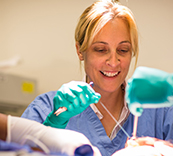Newsletter
Tessa Hadlock, MD
Dec 04, 2012

They Couldn’t Smile. Now They Can.
When Tessa Hadlock, MD was growing up, the family ethos was “do-it-yourself.” Everybody learned how to fix things, use tools, build a house.
Now, as one of the most sought-after facial plastic and reconstructive surgeons in the world, much of Dr. Hadlock’s work involves fixing human smiles.
“By far the best thing that happens in my work day, is someone coming in smiling after I’ve done this big operation on them. Nothing beats that they couldn’t smile, and now they can. It’s a huge gift to me as much as it is to the patient. Some Fridays I have two or three people who are smiling for the first time. Those rewards really make it.”
And, it can help make up for the impossible pressure that comes with Dr. Hadlock’s work as a surgeon and Director of Plastic and Reconstructive Surgery at Massachusetts Eye and Ear Infirmary (MEEI).
At the beginning of a clinical day without surgery, she sits on the corner of her desk on the 11th floor at MEEI, speaking and gesturing. She runs through details of cases with a room full of staff and residents, who scurry off with assignments and slip back into the room to give her information or seek a decision.

Patients from across the U.S. and other countries travel a great distance to have a consultation with Dr. Hadlock about their drooping faces. Bell’s Palsy, surgery, and genetics have taken away their smiles, and they want them back.
Helping patients understand the possibilities—and the limits—of what surgery can do for them is one of Dr. Hadlock’s biggest professional challenges. For physicians in many specialties, the commitment to patients in need is consuming.
“When you are taking care of a physical human condition,” Dr. Hadlock explains, “it’s a burden that just cannot be put aside. Doctors know what it’s like to have a life in your hands, to make a wrong judgment and miss, say, a heart attack, for example, in the case of internists; or for me, to slip and cause massive bleeding and really harm a human. And those burdens you can’t let go of.”
Since Dr. Hadlock’s husband is an internist, being able to talk about work issues at home is a little easier. She says the current medical climate is even tougher for his primary care specialty, so they give each other moral support.
Their four children, ages 5–16, contribute to a swirling household, where the parents make an effort to keep the home environment fun and educational, in between hockey practices for their three boys.
Medical Missions Deliver Value Abroad and at Home
One son has gone with her three times to Ecuador. Smiles now appear on faces in South America and other underserved nations because of Dr. Hadlock’s international work at clinics and teaching sessions. She is committed to providing this voluntary service for two different weeks per year.
“In fact, my oldest kids are teenagers now, and they always join me on the medical missions. They come into the operating rooms. They are totally bitten by the bug, if you will.
Medical missions give her a chance to perform her craft, building ears on a large number of patients with a rare deformity who would not otherwise have access to surgical reconstruction, for example. The trips also give her a chance to connect with surgeons from around the country, and exchange professional ideas.
Help Needed Getting to “No”
As her practice and reputation grow, Dr. Hadlock identifies a shortcoming in the medical profession: the lack of a process for saying “no.” Right now, medical institutions rarely provide operational support to physicians for career evaluation or setting limits. The most successful are the most vulnerable.
“You do a good job with patients, it brings in more patients. It brings in notoriety. It brings in lots of physician referrals, and you get busier and busier. And there is no built-in mechanism for saying ‘okay, this is how much this physician can handle and do a good job. So, in fact, we really can’t have you seeing more than X number of patients per week because we want to keep your quality high. We want to keep your mental health preserved.’ Instead, what they do is let people go like moths to a flame—because a physician is always going to work more. There’s a sick patient that has a problem they can help with. They are always going to want to do that. Our own mental health is jeopardized, or we careen out of control, and our personal lives disintegrate. I’ve seen it happen on several occasions.”

Protecting Family and Personal Time is a Must
Until the profession pushes this issue closer to the top of the agenda, physicians are on their own to maintain a healthy balance. Dr. Hadlock now attempts to spend more time outside of the hospital. She pursues a sense of well-being with activity around her family’s antique farm house. A large vegetable garden and bee-keeping with her husband and children help keep her sane, she says. Hiking and other outdoor activities are a must.
Even with four children of her own under age 16, Dr. Hadlock hosts foreign exchange students. Recently, they welcomed the teenage child of an out-of-state colleague.
“We pride ourselves on that kind of open door policy. I love the idea that people would even say ‘can my son come and live with you for a month and work in the research lab and see what goes on at Mass Eye & Ear?’ and that’s cool. That’s success.”
